Chữ Thái Việt

Chữ Thái Việt was devised by Hoang Tran and is an exercise in adapting an existing writing system to a new phonetic environment, specifically adapting the Tai-Kadai script Tai Dam to transcribe Vietnamese, a Mon-Khmer language. (Tai Dam is also called generically as Tai Viet to encompass all Tai ethnic groups in Vietnam who use this abugida to transcribe their languages such as the Thái Đen aka Tai Dam, Thái Trắng etc.) In Vietnamese this script is called Chữ Thái Cổ (Ancient Tai Script). Thái here refers to the Tai people who make up the largest minority group in Vietnam and not to be confused with the Thai people of Thailand. In Tai languages, the script is known as ![]() Xư Tay (Tai Script). Here we try to be conservative and true to the current script whenever possible, and alterations are made only from necessity and will be clearly indicated. One can also consider this as an introduction to Tai Viet from a Vietnamese perspective, since we will be using Vietnamese linguistic terms and conventions to describe the features of this script.
Xư Tay (Tai Script). Here we try to be conservative and true to the current script whenever possible, and alterations are made only from necessity and will be clearly indicated. One can also consider this as an introduction to Tai Viet from a Vietnamese perspective, since we will be using Vietnamese linguistic terms and conventions to describe the features of this script.
Notable Features
- Type of writing system: abugida/syllabic alphabet
- Direction of writing: left to write in horizontal lines
- Each consonant letter has a high and low form, which combined with the presence or absence of the two tones marks, is used to indicate the six tones of the Tai languages and Vietnamese.
- The high consonants are used for the syllable final letters -m, -n, -ng, -nh and low consonants for –t,-c,-ch,-p.
- Vowels are indicated using diacritics which appear above, below or to the left and/or right of the consonant letters.
- Consonants are ordered according to the phonetic distinctions made in Brahmic scripts proceeding from velar, palatal, dental, labial, sonorant, sibilant to guttural.
Chữ Thái Việt alphabet
Consonants – Tổ (蘇)
Tai Viet consonants called Tổ (蘇), a term borrowed from Tai, exist in low and high forms which function in tonal indication. There is no fixed order to the letters, but here we adopt the order derived from phonetic distinctions (velar, palatal…) used by the Brahmic scripts. The Latin transcriptions are in Vietnamese (Quốc Ngữ) and IPA. Since relatively minor consonantal differences exist between Tai and Vietnamese, here we did not invent any new letter but tried to pair up Vietnamese consonants to their corresponding or closest-sounding letters in Tai Viet. The name of each Tổ is made from its sound plus o or õ. The low consonants’ names are made with o and the high consonants’ with õ. Thus, it would be pronounced as
Low: co, kho, go, ngo etc…
High: cõ, khõ, gõ, ngõ etc
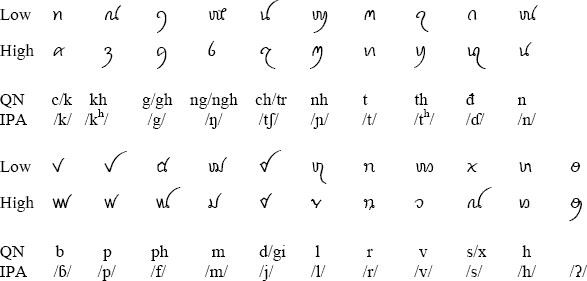
For final consonants (-m, -n, -ng, -nh and –t, -c, -ch, -p), the following conventions are observed
in Tai Viet. Though this might seem ambiguous to someone accustomed to Quốc Ngữ, the ambiguity (-ng/-nh and -t/-ch) is an accepted convention for users of Tai Viet. The nasal consonants in open syllables do not stop abruptly and allows the syllable to potentially be pronounced with all 6 tones in Vietnamese. However, in closed syllables where the final consonants cause an abrupt stop only the sharp and heavy tones are possible.
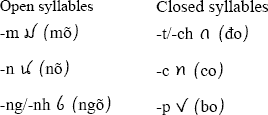
Vowel Diacritics/Letters – May (枚)
Tai Viet vowels are indicated by diacritics or letters which appear above, below, left or right of the consonant letter. The diacritics can also exist in combination. The vowel names are given by the following nomenclatural pattern May +/k/+ /vowel sound/. So, the Vietnamese monophthongs below would be named as follows:
may ca, may că, may câ
may co, may cô, may cơ
may ke, may kê
may ky
may cu, may cư
may coo
It is in terms of vocalic inventory that the phonetics of Tai and Vietnamese begin to diverge. While Tai uses a moderate number of vowels and vowel combinations, Vietnamese has relatively more, about 45 monopthongs, diphthongs, and triphthongs. Therefore, in this section, we’ll have to make alterations to the script, redefining the phonetic values of certain diacritics and establishing conventions for forming certain diphthongs and triphthongs. Alterations will be explained in the Notes section. All vowels below will be writen with the default guttural stop, /ʔ/, to demonstrate their spacial placement relative to a consonant.
Monophthongs
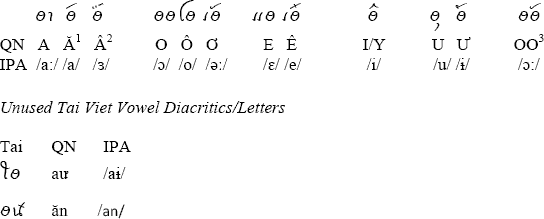
Diphthongs
Diphthongs in Vietnamese are made from the following five rules U+ Vowel, Vowel+ U, Ư+ Vowel, I+ Vowel, and Vowel + I. Since Tai Viet already has certain established diacritics and conventions for certain diphthongs, those we will keep. Otherwise, we will establish new productive conventions for creating the remaining diphthongs in Vietnamese.
- U+Vowel4 – the consonant võ will be used with the leading consonant to form a consonantal cluster e.g. kw, chw, etc… the above vowel diacritics will be placed over the võ and all other vowel diacritics/letters will be placed according to Tai Viet conventions.
- Vowel+U5 – the consonant võ will be used with the leading consonant to form a consonantal cluster e.g. kw, chw, etc… the above vowel diacritics will be placed over the leading consonant, right vowel diacritics/letters will precede võ, left vowel diacritics/letters will not be used with võ but with may cu and will have priority in pronunciation to may cu.
- Ư+Vowel – according to Tai Viet established diacritic
- I +Vowel- according to Tai Viet established diacritic
- Vowel + I- according to Tai Viet convention i.e. adding dõ
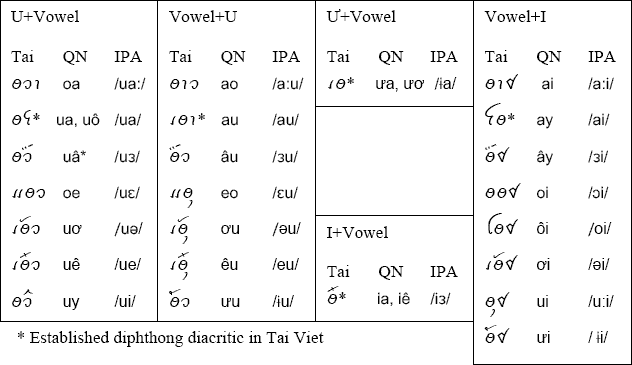
Triphthongs
Vietnamese triphthongs are likewise made from the reapplication of the above rules.
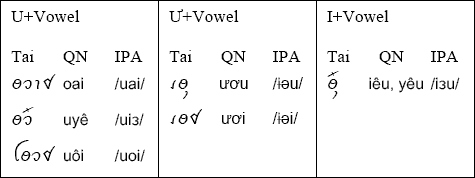
Notes:
- Redefined phonetic value from /aŋ/ to /a/
- Redefined phonetic value from /an/ to /ɜ/
- Invented sign and diacritic combination for /ɔ:/
- New convention
- New convention
Tones
Tai languages have 6 tones which are equivalent to Vietnamese. Tones are determined by the consonant and tonal diacritics above the leading consonant or tonal letters at the end of the syllable. Both conventions are equally valid in writing Tai Viet, though the used of tonal diacritics, which was borrowed from the Lao Script, is the more common of the two.

Sample Text
First few lines of “Truyện Họ Hồng Bàng” from Linh Nam Chích Quái, a story of the ethnogenesis of the Vietnamese people given in the orginal Literary Chinese version, Vietnamese Chữ Nôm translation, Vietnamese Quốc Ngữ translation, Vietnamese Thái Việt translation, and English translation.
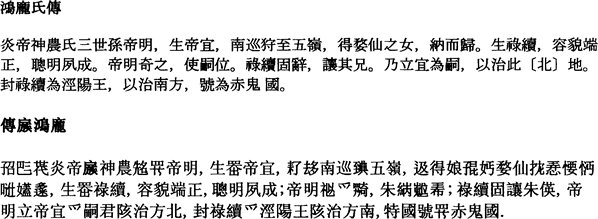
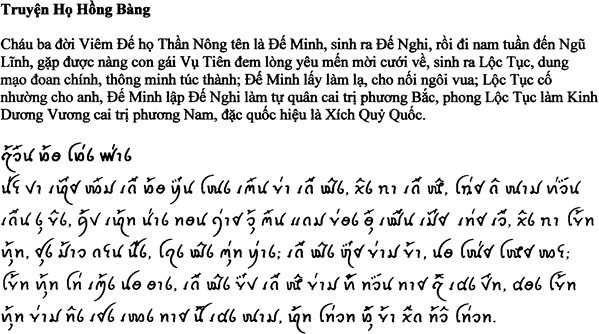
Tale of the Hong Bang Clan
The third generation descendant of Viem De (Yan Emperor) of the Than Nong Clan (Shennong)
Clan) whose name was De Minh begot De Nghi, then journeyed south arriving at the Ngu Linh
(Wulinh) Mountains , where he met Vu Tien, fell in love, and married her. They begot Loc Tuc
who was upright in appearance, intelligent and diligent; impressed De Minh chose Loc Toc as
his successor. Loc Toc insists on conceding to his older brother, De Minh crowned De Nghi as
the successor King to rule the North, crowned Loc Tuc as King Kinh Duong to rule the South,
King Kinh Duong gave the country the name of Oich Quy Quoc, Great Nation of the South.
Links
Free Tai Dam fonts
htp://www.sil.org/computing/fonts/sildb/
Free Tai Viet fonts and keyboard drivers
http://www.tavultesoft.com/
Information about Tai Dam language, literature and culture (and Tai Dam fonts)
http://www.seasite.niu.edu/tai/TaiDam
Information, fonts, and material about Tai Viet in Vietnamese
http://www.huesoft.com.vn/chuthaivietnam/TINTUC/
